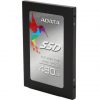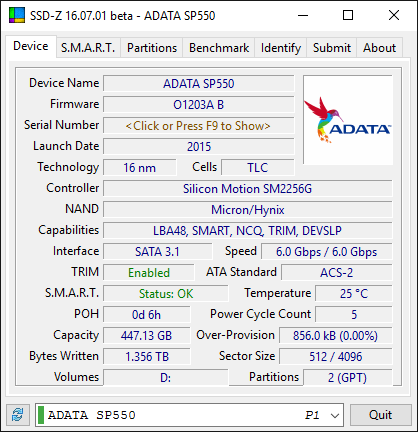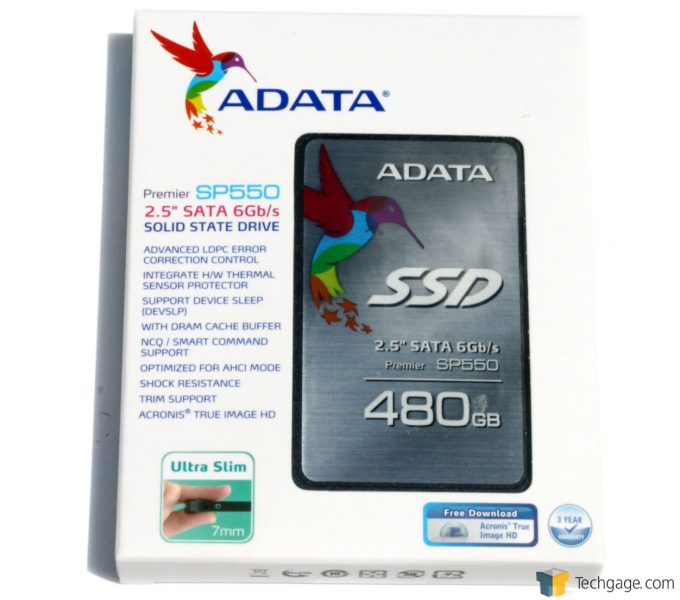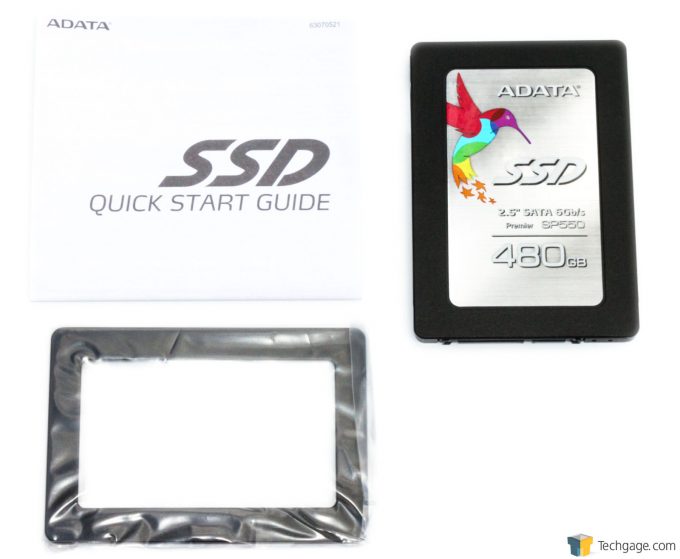- Qualcomm Launches Snapdragon 4 Gen 2 Mobile Platform
- AMD Launches Ryzen PRO 7000 Series Mobile & Desktop Platform
- Intel Launches Sleek Single-Slot Arc Pro A60 Workstation Graphics Card
- NVIDIA Announces Latest Ada Lovelace Additions: GeForce RTX 4060 Ti & RTX 4060
- Maxon Redshift With AMD Radeon GPU Rendering Support Now Available
ADATA Premier SP550 480GB Solid-State Drive Review

It’s easy to think that all budget SSDs perform the same, but ADATA proves otherwise with its Premier SP550. This TLC drive looks the part of modest SSD, but under the hood, it has a trick up its sleeve: 8GB SLC cache. The best part? That perk doesn’t add much to the cost of the drive, making this one SSD well worth looking out for.
Page 1 – Introduction; A Look At ADATA’s SP550 SSD
The benefits of solid-state drives are easy to wax poetic about, but the proof is in having utilized a system equipped with one. The sheer responsiveness can feel like a full system upgrade and raises the bar for what to expect from the device (even a console can see a boost!).
In the modern age of instant gratification having programs open on demand instead of waiting for them to load just seems natural, which may be why the idea of waiting half a minute or longer for a computer to boot seems ludicrous today.
Unfortunately the biggest factor slowing solid-state drive adoption has always been the steep cost of entry. Budget SSDs may not be glamorous and certainly don’t get a lot of attention, but an entry-model SSD is still playing in a completely different league from the fastest hard drives available.
This brings us to the Premier SP550 series, ADATA’s entry-model solid-state drives which feature TLC flash with SLC buffering. Please note ADATA does sell the SP550 in SATA and M.2 form-factors, but for this review we will be benchmarking the 480GB SATA model.
The quickest way to bring down the cost of flash NAND is to simply pack more bits into each NAND flash cell, so it should be no surprise that the vast majority of budget SSDs now utilize TLC flash. The tradeoff is of-course NAND endurance and performance. ADATA works around this by dedicating 8GB of the NAND as an SLC fast-write cache. On one hand this means the SLC NAND would see a significant increase in wear from the constant writes, far more so than the rest of the drive. At the same time a quirk of how SLC NAND functions gives it an exponential increase in write endurance that allows the SLC NAND to handle this kind of wear.
| 120GB | 240GB | 480GB | 960GB | |
| Form Factor | 7mm 2.5-inch (2mm spacer included) | |||
| Interface | SATA 6Gbps | |||
| Controller | Silicon Motion SM2256 | |||
| DRAM | Samsung 256MB DDR3 | |||
| Flash Memory | Synchronous 16nm TLC (SLC buffering) | |||
| Sequential Read / Write | 560 / 410 MB/s | 560 / 510 MB/s | 560 / 510 MB/s | 520 / 490 MB/s |
| 4K Random Read / Write | 60K / 70K IOPS | 75K / 75K IOPS | 75K / 75K IOPS | 80K / 35K IOPS |
| Endurance | 90TBW | 90TBW | 180TBW | 360TBW |
| Street Price | $47 | $65 | $120 | $225 |
| Warranty | Three Years | |||
Unlike some other budget SSDs that are forgoing the DRAM cache it is nice to see ADATA’s SP550 still makes use of a DDR3 256MB DRAM cache buffer for improved performance consistency. As for data protection, the Silicon Motion SM2256 controller utilizes the standard combination of LDPC and a form of NAND RAID parity checking for monitoring of data integrity and ECC support.

For utilities ADATA offers a download of Acronis True Image HD for data migration use with its SSDs. Also available is ADATA’s SSD Toolbox software which provides firmware updates, secure erase functionality, OS optimization, drive status information and of course diagnostic options.
Invalid slider ID or alias.| SSD Test System | |
| Processor | Intel Core i7-4771 @ 3.7GHz |
| Motherboard | ASUS Z97-A – BIOS 2801 |
| Memory | Crucial Ballistix 8GBx4 DDR3-1600 |
| Graphics | EVGA GeForce GTX 750 Ti SC |
| Audio | Onboard |
| Storage | ADATA SP550 480GB (SATA) Intel 520 240GB (SATA) Intel 730 240GB (SATA) Kingston Predator 240GB (PCIe) Samsung 950 Pro 512GB (NVMe PCIe) |
| Power Supply | BitFenix Fury 650W |
| Chassis | Cooler Master HAF 932 |
| Cooling | Noctua NH-D14 |
| Et cetera | Windows 10 Pro x64 |
To ensure all drives have fair representation regardless of capacity we use IOMeter to conduct continuous file writes beyond twice the rated capacity of each SSD. This will make sure every block has been written to at least once including the unaddressable spare area present on all solid-state drives, ensuring all drives begin testing in a normalized “dirty” state.
SATA drives will be tested on an Intel 6Gbps SATA port, while PCIe cards will use the PCIe Gen 3 x8 slot to the processor. M.2 drives will make use of a PCIe adapter card in this same slot to bypass the M.2 x2 interface bottleneck, allowing drives to utilize the maximum bandwidth (PCIe Gen 3 x4) that the M.2 interface supports. Where applicable we will ensure drives are using the NVM Express protocol.
The test system’s processor has had Intel’s Speedstep and Turbo Boost functionality disabled and all cores are locked to the same 3.7GHz frequency in order to ensure maximum consistency between test runs.
Support our efforts! With ad revenue at an all-time low for written websites, we're relying more than ever on reader support to help us continue putting so much effort into this type of content. You can support us by becoming a Patron, or by using our Amazon shopping affiliate links listed through our articles. Thanks for your support!






